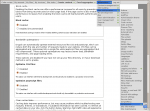
example
Table of Contents Known Issues
Various known issues with the Table of Contents module.
Teaser appear, FCKeditor accentuated letters, Back to top arrow, Filters interaction (JavaScript removal,) headers numbering, double numbering...
To Do List API
To Do List offered Hooks
Since version 1.1, the To Do List module includes a few module_invoke() calls that other modules can catch via one of the following hooks.
SimpleMenu Known Issues
SimpleMenu Disappears
There following are a few of the main reasons why SimpleMenu disappears.
Pop-up Windows
By default, SimpleMenu wants to hide itself in pop-up windows. This is a feature.
The reason is that many websites will open pop-up windows for all kinds of extra-features such as uploading an image or printing some description of an image or the definition of a word or product.
These windows should not include the SimpleMenu bar.
There is a dedicated page giving several different ways to fix this problem on your website.
Menu Overflow
Insert Node Parameter: plain (6-1.2) [no content]
The plain keyword is used to avoid having the content being inserted put inside a tag. By default, the content is inserted inside a <span> or a <div> tag (<span> is used if the output does not include <div>, <p> and other such tags.)
Although one could overload the theme_InsertNode_node() theme function, it is at times practical to be able to use both methods.
The plain keyword does not otherwise generate any output.
This keyword primary use is for adding CCK parameters inside HTML code as proposed by one of our users (see here):
<input ...
Insert Node Known Issues
The following are problems that have not been resolved and will probably not be.
Tag not transformed
At times, you enter the tag as in [node:123 cck=title] and it is not converted by the filter.
There are 3 common reasons for this to append:
- You did not select the filter in your Input formats;
- You did not select the format that uses the filter in that node; or
- There is a syntax error in the tag.
The 3rd one is certainly the most likely explanation once you made sure that the filter was effectively selected for that node. In many cases, it will be the missing ...
Creating Groups with Taxonomy VTN
Taxonomy VTN adds many fields in your taxonomy forms. When editing your taxonomy, one field is called Taxonomy VTN Group. This field is used to group different vocabularies (i.e. taxonomies) together in a group.
 The field accepts one or more group names. The names are case insensitive and are separated by commas. For instance, you could have three names such as: Kitchen, Utensils, Stainless Steel. Then another vocabulary could mention Kitchen and yet another Utensils, Wood.
The field accepts one or more group names. The names are case insensitive and are separated by commas. For instance, you could have three names such as: Kitchen, Utensils, Stainless Steel. Then another vocabulary could mention Kitchen and yet another Utensils, Wood.
The groups change the display in the Taxonomy VTN root page. A specific group can also be accessed using the URL:
Get Variable
Pop one string, search for a variable of that name, and push its value on the stack. This action first checks for local variables in the current function. If there isn't such a variable, or the execution is not in a function, then the corresponding global variable is read.
The variable name can include sprite names separated by slashes and finished by a colon as in. Only global variables are accessible in this way.
Example:
/Sprite1/Sprite2:MyVar
In this example, the variable named MyVaris queried from the sprite named Sprite2which resides in Sprite1.
In a browser you can add ...
FSCommand2
Execute the external command (s2) passing on parameters (s3, s4 ... sn.) The external command is likely a JavaScript function.
IMPORTANT NOTES
Ammar Mardawi sent a correction for this action and it looks like it works the way it is described now.
DefineScalingGrid
This definition is used so the scaling factors applied on an object affects only the center of the object fully. The borders are only affected in one direction and the corners are not scaled (note, restrictions apply, see below.) This is quite useful to draw a scalable button or window.
Fig 1 — Sample button being scaled with a scaling grid
Appendix A — The geometry in SWF — Images
When appropriate, images can also be included in SWF files. All the images can be full color and also have an alpha channel.

